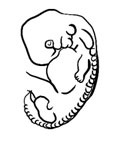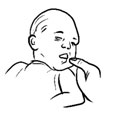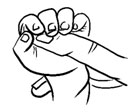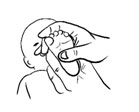Retained primitive reflexes can affect children’s learning, behaviour and emotions. They are integrated and switched off when an infant starts to have conscious control of his/her movements. They have a limited time span and are switched off or integrated through normal childhood activities. If the reflexes are retained they can lead to neuro-developmental delay and poor sensory integration e.g. they can impair balance which will cause a child difficulty in judging space, distance, depth and speed. Balance is vital for everyone, for example, when astronauts lose their sense of balance in space they start to write from right to left, reverse numbers and letters and produce mirror writing. The following reflexes are the ones that are most often retained.
- Fear Paralysis Reflex
- Moro Reflex
- Rooting Reflex
- Suck Reflex
- Asymmetrical Tonic Neck Reflex
- Palmar Reflex and Plantar Reflex
- Spinal Galant Reflex
- Tonic Labyrinthine Reflex
- Symmetrical Tonic Neck Reflex
 The Fear Paralysis begins to function very early after conception and should normally be integrated before birth. It can be characterised by withdrawal, reluctance at being involved in anything new, fear of different circumstances, clinginess, timidity etc.
The Fear Paralysis begins to function very early after conception and should normally be integrated before birth. It can be characterised by withdrawal, reluctance at being involved in anything new, fear of different circumstances, clinginess, timidity etc.
The Fear Paralysis Reflex may present in any of the following symptoms;
 This reflex holds the child in a flight and fight response. The reflex has to cover all eventualities so the child’s sympathetic hormonal and neurological response is activated, preparing the body to protect itself. It is the reflex that allows the body to take the first breath of life automatically.
This reflex holds the child in a flight and fight response. The reflex has to cover all eventualities so the child’s sympathetic hormonal and neurological response is activated, preparing the body to protect itself. It is the reflex that allows the body to take the first breath of life automatically.
The Moro Reflex should be integrated between 4 – 5 months and my present as any of the following symptoms;
If the Moro reflex persists beyond three to six months of age it becomes an automatic therefore uncontrollable overreaction, overriding the newly acquired higher centre decision making.
 This reflex is there in preparation for suckling. The combination of rooting and suck reflexes ensures that a baby’s head turns toward a source of food and the mouth opens wide enough to accommodate a nipple.
This reflex is there in preparation for suckling. The combination of rooting and suck reflexes ensures that a baby’s head turns toward a source of food and the mouth opens wide enough to accommodate a nipple.
The Rooting Reflex should be integrated between 3 – 4 months, retention may present as any of the following symptoms;
Associated with this reflex is a response known as the Babkin response, which is a neurological link between the hand and the mouth. This can be seen as kneading movements of the hand associated with suckling. This is a two way response; hand movements can affect speech and speech my affect hand movement and dexterity.
 If a Suck Reflex is not adequately integrated, the tongue projects forwards before moving backward in the normal swallow action. This tongue thrust continually pushes the front teeth forwards, altering the shape of the maxillary arch.
If a Suck Reflex is not adequately integrated, the tongue projects forwards before moving backward in the normal swallow action. This tongue thrust continually pushes the front teeth forwards, altering the shape of the maxillary arch.
The Suck Reflex should be integrated between 3 – 4 months, retention may present as any of the following symptoms;
 The reflex continues after birth and plays an important part in the development of hand eye coordination, object and distance perception.
The reflex continues after birth and plays an important part in the development of hand eye coordination, object and distance perception.
If the ATNR is retained, difficulty may be experienced with tasks which involve both left and right sides of the body including eyes, ears, limbs etc. Establishment of dominant hand, foot, ear or eye may be difficult. Turning the head may cause a visual image to momentarily disappear or parts of the visual field to be missed. Visual tracking and judgement of distance may be therefore be affected.
The Asymmetrical Tonic Neck Reflex should be integrated between 6 – 7 months, retention may present as any of the following symptoms;
 The Palmar Reflex and the Plantar reflex should integrate at about the same time, between 4 – 6 months. The Palmar and Plantar reflexes are part of a group of reflexes that develop in the uterus and whose common characteristic is to grasp.
The Palmar Reflex and the Plantar reflex should integrate at about the same time, between 4 – 6 months. The Palmar and Plantar reflexes are part of a group of reflexes that develop in the uterus and whose common characteristic is to grasp.
 The Palmar and Plantar reflexes should be integrated between 5 – 6 months, retention may present as any of the following symptoms;
The Palmar and Plantar reflexes should be integrated between 5 – 6 months, retention may present as any of the following symptoms;
Palmar
- Poor fine motor skills;
- Poor pen-grip and handwriting;
- Slumped posture when writing or working over desk;
- Doesn’t enjoy writing;
- Poor spelling.
Plantar
- Balance and walking is affected
- Delayed walking beyond 14 months
- Awkward running style and poor balance
- Toes curl under when putting on shoes;
Both the Palmar and Plantar reflexes are thought to be a continuation of an earlier stage of human evolution, when it was necessary for the baby to cling to its mother for safety. If retained beyond the first few months, these reflexes can impede independent finger and toe movement, affecting fine motor skills such as writing.
 This reflexes wriggling motion appears to take an active role in the birth process, with movements of the hip helping the baby to work its way down the birth canal.
This reflexes wriggling motion appears to take an active role in the birth process, with movements of the hip helping the baby to work its way down the birth canal.
The Spinal Galant Reflex should be integrated between 12 – 13 months, retention may present as any of the following symptoms:
The Spinal Galant reflex may be activated by light pressure in the lower back. In the classroom, just leaning back against the chair may activate the reflex and wriggling in bed whilst asleep may cause bed wetting.
 The TLR involves the vestibular system and the sense of balance and position in space and the vestibular interaction with other senses. The reflex should be fully integrated by the end of the first year of life.
The TLR involves the vestibular system and the sense of balance and position in space and the vestibular interaction with other senses. The reflex should be fully integrated by the end of the first year of life.
 The Tonic Labyrinthine Reflex may present itself in the following:
The Tonic Labyrinthine Reflex may present itself in the following:
If the Tonic Labyrinthine reflex is not integrated it will constantly disturb the sense of balance and the integration with other sensory systems. This has an effect on reading skills and can cause car sickness.
 The STNR is helps the baby with the action of crawling and to start tracking, as well as establishing contralateral movement.
The STNR is helps the baby with the action of crawling and to start tracking, as well as establishing contralateral movement.
 The Symmetrical Tonic Neck Reflex should be integrated between 12 – 13 months, and may present as any of the following symptoms;
The Symmetrical Tonic Neck Reflex should be integrated between 12 – 13 months, and may present as any of the following symptoms;
Many children have one or two reflexes that have not been integrated and may be functioning well. It is only when there is a cluster of reflexes that have not been integrated that problems begin to present themselves in the form of feeding issues, emotional issues , learning issues and behavioural issues.
Common questions that would suggest retained primitive reflexes are:
Common questions that would suggest retained primitive reflexes are:

